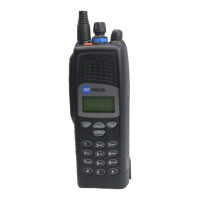TP9100 Service Manual Circuit Descriptions 51
© Tait Electronics Limited May 2005
3.1 Transmitter Circuitry
Introduction For a block diagram of the transmitter circuitry, refer to Figure 3.2.
Exciter The exciter is different between the variants of the radio. The VCO buffer
output is amplified through a combination of BJT discrete stage Q107
(B1 and H6), integrated amplifier IC100 (H5 and H6), and BJT discrete
stage Q100 (H5 and H6). The exciter produces approximately +20dBm
output to the driver.
Driver The LDMOS driver stage Q103 produces up to 1.5W output that is power-
controlled via Q101.
Power Amplifier The final-stage power amplifier consists of a single LDMOS device Q106
producing up to 5W output for B1 and 4W output for H5 and H6.
Final bias control comes from the IDAC channel of IC204 and one of the
operational amplifiers making up IC202. Wave shaping of the bias signal is
performed by one of the operational amplifiers of IC101. In addition, the
bias signal can be inhibited by an out of lock signal from the synthesizer.
Power Control Loop Calibration is used to adjust the power control loop, thus setting the output
of the transmitter to one of four preferred power levels (1, 2, 3, and 5W for
B1 and 1, 2, 2.5, and 4W for H5 and H6). The control mechanism for this
loop is via a DAC channel of IC204 and one of the operational amplifiers
making up IC202. Wave shaping, filtering and feedback from current-sense
resistor R150 is then performed by two of the operational amplifiers making
up IC101. The power control loop will be inhibited if for any reason an out-
of-lock signal is detected from the synthesizer. This ensures that no
erroneous signals are transmitted at any time.
Temperature Sensor For added protection, a temperature sensor ensures that the transmitter
power is reduced to very low levels should a temperature threshold be
exceeded. If the temperature does not decrease, the transmitter is switched
off.

